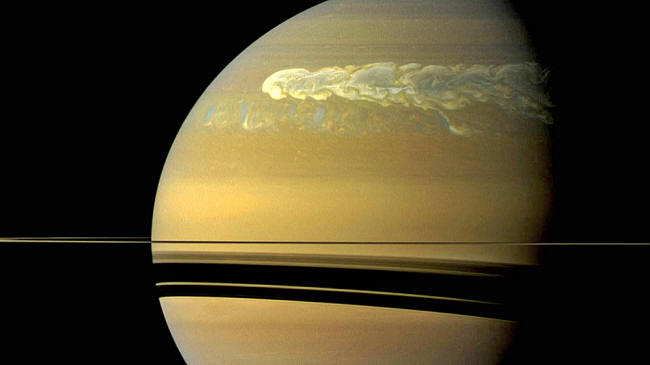|

by Stephen Smith
October
23, 2019
from
Thunderbolts Website
Italian version

A Great White Spot storm
that raged in 2010 and 2011.
Credit: JPL-CALTECH/NASA, SSI
Saturn's Reign
Recently, planetary scientists announced a new type of storm
swirling near Saturn's North Pole.
Robert West from
Caltech and
JPL says the origins of the storms
and how they relate to other weather phenomena on Saturn,
"are still
mysterious."
The planet Saturn could
be thought of as the captain of its own solar system, with a family
of 82
moons...
Saturn emits more energy
than it receives:
2.3 times more, so it
is being powered by another source.
It is also probable
that
the interior of the planet has
its own heat.
There is good evidence
that Saturn once existed as an independent body from the Sun.
As such, it would have
received more energy in the recent past, its power source usurped by
the Sun.
Saturn exhibited many changes over the (almost) 40 years since the
Voyager spacecraft flew by the
giant gas planet and several of its largest moons.
Saturn's
magnetosphere grew by more than a million kilometers,
contracted, and then started expanding again.
Saturn's
B ring "spokes" disappeared and
then reappeared.
The so-called "Dragon
Storm" broke up, moved toward the poles, and then
erupted again.
Every so often Saturn breaks out with a "great
white spot" three times larger than Earth.
Traditional models of
Saturn cannot explain such a periodic outburst, but an
intense lightning discharge deep in the atmosphere could cause
vertical jets similar to the
sprites in Earth's upper atmosphere.
Its electrical connection
to the Solar System can explain the effects that
Cassini discovered on and around
Saturn.
The most likely
explanation for the storms on Saturn is that they are equivalent
to sunspots.
As the Sun changes
its behavior over the course of a 22 year cycle, the electrical
output that connects it with its family of planets varies.
If Saturn's Great White Spots, Dragon Storm, and
ring spokes are driven by the same galactic
Birkeland currents that drive
the Sun, they should get
stronger and closer to the equator as the sunspot cycle
oscillates.
It appears that it is
what happened over the past three decades.
Evidence suggests that
Saturn was once of greater stature, but was dethroned from
its position of prominence in the sky.
It was not the tiny
pinprick of light that can be seen on dark nights. Rather, it was
worshipped as the central luminary, the all-powerful Sun. If that
was the case, then its current position in the Solar System is far
removed from what it was.
Without going into details that are elaborated elsewhere, that
disturbance and rearrangement of planets means that Saturn is the
way it is not because of how it was conventionally formed, but
because it is closer to being a star than it is to being a planet.
Indeed, as our ancestors
tell us, it was a star...
|


